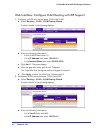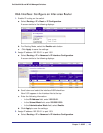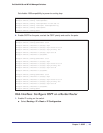
Chapter 7. OSPF | 86
7
7. OSPF
Open Shortest Path First
This chapter provides the following examples:
• Inter-area Router on page 87
• OSPF on a Border Router on page 92
• Stub Areas on page 98
• nssa Areas on page 107
• VLAN Routing OSPF on page 116
• OSPFv3 on page 122
For larger networks Open Shortest Path First (OSPF) is generally used in preference to RIP.
OSPF offers several benefits to the administrator of a large or complex network:
• Less network traffic:
- Routing table updates are sent only when a change has occurred.
- Only the part of the table which has changed is sent.
- Updates are sent to a multicast, not a broadcast, address.
• Hierarchical management, allowing the network to be subdivided.
The top level of the hierarchy of an OSPF network is known as an autonomous system (AS) or
routing domain, and is a collection of networks with a common administration and routing
strategy. The AS is divided into areas: Intra-area routing is used when a source and destination
address are in the same area, and inter-area routing across an OSPF backbone is used when
they are not. An inter-area router communicates with border routers in each of the areas to which
it provides connectivity.
The M4100 and M7100 Managed Switch operating as a router and running OSPF determines
the best route using the assigned cost and the type of the OSPF route. The order for choosing a
route if more than one type of route exists is as follows:
• Intra-area.
• Inter-area.
• External type 1: The route is external to the AS.
• External type 2: The route was learned from other protocols such as RIP.


















